Red Paper Lantern Medusa
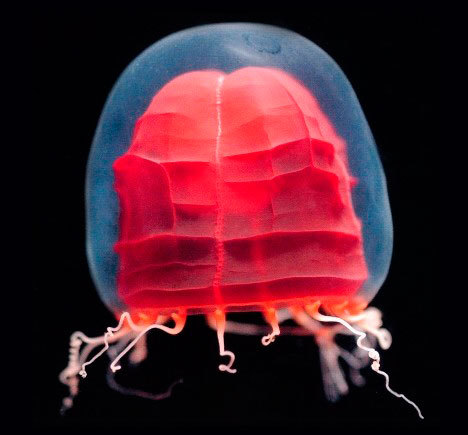

Red Paper Lantern Medusa
Pandea rubra
The Red Paper Lantern resembles a floating, Japanese paper lantern in the deep sea. It has the ability to crumple and wrinkle its bright, red bell, and it is located at depths between 550m to 1200m. It has also been nicknamed the “origami jelly.”
Photo credit: https://commons.wikimedia.org/wiki/Category:Pandea_rubra
http://www.thegorgeousdaily.com/pandea-rubra/
More Posts from Bioluminescentoceangoddess and Others



Black Dragonfish
Idiacanthus atlanticus
The Black Dragonfish are needle-like fish that migrate between 500m and 2000m in the deep ocean. Females are black with 6 stripes and lack a barbel, pelvic fins, and sharp teeth. Males, on the other hand, are dark brown and have a barbel, which is the light producing structure on its chin. Furthermore, it uses bioluminescence to detect prey instead of lure prey.
Photo credit: https://scitechdaily.com/scientists-learn-secrets-from-ultra-black-skin-that-allows-deep-sea-fish-to-lurk-unseen/
https://steemit.com/life/@munnashah/the-most-terrible-and-surprising-7-animals-of-the-sea
https://knowyourmeme.com/photos/995601-thalassophobia


Spookfish
Winteria telescopa
The Spookfish’s eyes act as a telescope and are designed to maximize light in the deep ocean. Its eyes contain rod cells that help distinguish between ambient light and bioluminescent light. This adaptation helps avoid predators and catch prey.
Picture Credit: https://www.natureplprints.com/deep-sea/deep-sea-fish-winteria-telescopa-15230734.html

Predatory Copepod
Paraeuchaeta barbata
Copepods are a type of zooplankton or tiny creature that feeds larger animals in the ocean such as, fish. They are crustaceans that have two long antennas and a sensory eye called an ocelli, which can only sense light. This copepod is located between 200m to 1500 m in the deep ocean. You may notice the copepod is red in color. The color is an adaptation that makes it difficult for predators to see the copepod because red wave lengths do not penetrate this depth (mostly blue and indigo light). Even though this creature tiny, it is a vital food source for many animals in the abyssal zone of the ocean.
Photo credit: http://www.arcodiv.org/watercolumn/copepod/Paraeuchaeta_barbata_large.html


Giant Bell Jelly
Scrippsia pacifica
The Giant Belly Jelly has 256 tentacles attached to a gelatinous bell-shaped base. Like most cnidarians, the Giant Belly Jelly uses specialized stinging cells called nematocysts to catch its prey. When fish and other prey swim into its tentacles, the sensory projection on the cnidocyte (cell that holds the nematocysts) is activated. Then the nematocysts and barb are released, hitting the vulnerable prey and releasing a toxin into the prey’s body. The Giant Bell Jelly is found at 400 m in the ocean. It is related to the jellyfish, but it is categorized as a Hydrozoa (similar to the Portuguese- man-o-war)
https://vimeo.com/42551565
Photo Credit: https://www.pinterest.cl/pin/467107792572034837/
https://courses.lumenlearning.com/ivytech-bio1-1/chapter/phylum-cnidaria/


Helmet Jelly
Periphylla periphylla
The Helmet Jelly can be found at all depths of the ocean. This vibrant and strange jellyfish tends to proliferate in Norwegian fjords. They are one of the dominant predators in these isolated ecosystems.
Photos
http://www.seawater.no/fauna/cnidaria/periphylla.html
https://www.bigfishexpeditions.com/2019/01/24/norway-deepwater-shark-diving-2018/helmet-jelly/





Wake up babe new fish dropped


Googly-eyed glass squid
Teuthowenia pellucida
The Googly eyed squid is a rare oddity that is found in the southern hemisphere. It has a large, spherical head that is filled with water and teeny, tiny tentacles that help propel it through the water. If it comes across a predator, it deflates its head and draws its tentacles into its cavity. On the other hand, it may also fill the cavity with water to increase its size, and intimidate the predator. If all fails, it will ink and try to escape through the darkness. Furthermore, baby squids can be found at the surface (0-600m); then slowly migrate downwards as they mature into adults (1600-2500m).
Photo credit: http://animaladay.blogspot.com/2011/07/googly-eyed-glass-squid.html
https://faunafabula.tumblr.com/post/5999675353/googly-eyed-glass-squid-teuthowenia-pellucida

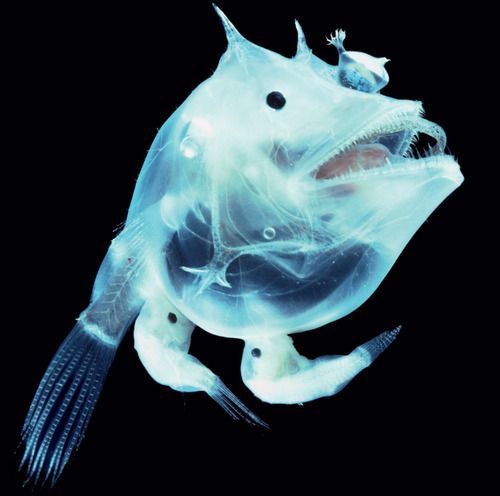
Deep-sea white anglerfish
Haplophryne mollis
The Deep-sea white anglerfish is a ghostly white creature found at depths between 1000m to 4000m. The strange bulge between its eyes is a bioluminescent lure. The main fish above is a female and the tiny fish attached to her body are males. Since it is difficult to find mates in the deep ocean, male fish latch onto the female with hooked teeth. Even though the male fish are parasitic, they are eventually reduced to pockets of sperm that are used for reproduction. For all you fellas out there that have a rough time with the ladies, be thankful that you are at least not a bag of gonads floating through the ocean.
Photo credit: https://www.pinterest.co.uk/pin/440297301041956897/
https://news.cgtn.com/news/3d3d414d3559444f7a457a6333566d54/share_p.html
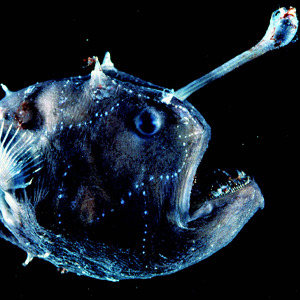

Football Fish
Himantolophus paucifilosus
The Football fish is a deep sea angular fish located between 1000 to 4000 meters in the ocean. The glowing dots on its body are sensory organs called neuromast that help the fish detect changes in the water.
Photo credit: https://alchetron.com/Footballfish
https://www.amazon.com/Creatures-Deep-Search-Monsters-World/dp/1770852816

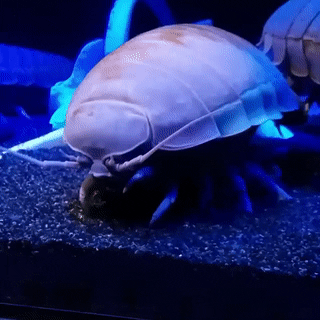
Giant Isopod
Bathynomus kensleyi
The Giant Isopod is an unsettling deep sea creature that crawls along the ocean floor scavenging for animal remains and detritus. These invertebrates are part of phenomenon known as abyssal gigantism, which is the tendency for deep-sea dwelling invertebrates to be larger than their shallower-water counter parts. The Giant Isopod is found between 310m to 2140m in the ocean.
Photo credit
https://seatrench.tumblr.com/post/615873390014791680/giant-isopod-bathynomus-sp-source
https://alchetron.com/Giant-isopod
-
 ghoulish-gazebo liked this · 1 year ago
ghoulish-gazebo liked this · 1 year ago -
 flying-for-freedom liked this · 1 year ago
flying-for-freedom liked this · 1 year ago -
 mycellpics liked this · 1 year ago
mycellpics liked this · 1 year ago -
 heavenlyhorses reblogged this · 2 years ago
heavenlyhorses reblogged this · 2 years ago -
 melancholicapple reblogged this · 2 years ago
melancholicapple reblogged this · 2 years ago -
 cackling-concerto liked this · 2 years ago
cackling-concerto liked this · 2 years ago -
 radradish99 liked this · 2 years ago
radradish99 liked this · 2 years ago -
 hairlice reblogged this · 2 years ago
hairlice reblogged this · 2 years ago -
 pinktintedglass liked this · 2 years ago
pinktintedglass liked this · 2 years ago -
 swagappeal liked this · 2 years ago
swagappeal liked this · 2 years ago -
 allstarsmash liked this · 2 years ago
allstarsmash liked this · 2 years ago -
 tidalpools liked this · 2 years ago
tidalpools liked this · 2 years ago -
 a-nightmare-to-the-eyes reblogged this · 2 years ago
a-nightmare-to-the-eyes reblogged this · 2 years ago -
 highemperorcuco liked this · 2 years ago
highemperorcuco liked this · 2 years ago -
 asirenbyanyothername reblogged this · 2 years ago
asirenbyanyothername reblogged this · 2 years ago -
 0022222222221111111111 liked this · 2 years ago
0022222222221111111111 liked this · 2 years ago -
 highemperorcuco reblogged this · 2 years ago
highemperorcuco reblogged this · 2 years ago -
 i-rather-be-lost reblogged this · 2 years ago
i-rather-be-lost reblogged this · 2 years ago -
 i-rather-be-lost liked this · 2 years ago
i-rather-be-lost liked this · 2 years ago -
 strawberry707 reblogged this · 2 years ago
strawberry707 reblogged this · 2 years ago -
 strawberry707 liked this · 2 years ago
strawberry707 liked this · 2 years ago -
 eborg1 liked this · 2 years ago
eborg1 liked this · 2 years ago -
 psychotherium reblogged this · 2 years ago
psychotherium reblogged this · 2 years ago -
 low-level--00 reblogged this · 2 years ago
low-level--00 reblogged this · 2 years ago -
 low-level--00 liked this · 2 years ago
low-level--00 liked this · 2 years ago -
 elliecrain liked this · 2 years ago
elliecrain liked this · 2 years ago -
 4given44ever reblogged this · 2 years ago
4given44ever reblogged this · 2 years ago -
 monsoonceroom liked this · 3 years ago
monsoonceroom liked this · 3 years ago -
 amethysthorizon reblogged this · 3 years ago
amethysthorizon reblogged this · 3 years ago -
 lack-a-daisicaal liked this · 3 years ago
lack-a-daisicaal liked this · 3 years ago -
 giedislime liked this · 3 years ago
giedislime liked this · 3 years ago -
 lily-ily-ly liked this · 3 years ago
lily-ily-ly liked this · 3 years ago -
 manhaterturtles4jb liked this · 3 years ago
manhaterturtles4jb liked this · 3 years ago -
 rjrgii2 liked this · 3 years ago
rjrgii2 liked this · 3 years ago -
 battlemage94 liked this · 3 years ago
battlemage94 liked this · 3 years ago -
 lauraatulsa reblogged this · 3 years ago
lauraatulsa reblogged this · 3 years ago -
 lauraatulsa liked this · 3 years ago
lauraatulsa liked this · 3 years ago -
 bi6money reblogged this · 3 years ago
bi6money reblogged this · 3 years ago -
 happyzenmonk liked this · 3 years ago
happyzenmonk liked this · 3 years ago -
 hugoshouseart liked this · 3 years ago
hugoshouseart liked this · 3 years ago -
 catcrusher liked this · 3 years ago
catcrusher liked this · 3 years ago -
 sortbyrelevance liked this · 3 years ago
sortbyrelevance liked this · 3 years ago -
 donnerpartyofone liked this · 3 years ago
donnerpartyofone liked this · 3 years ago
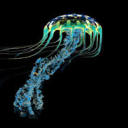
Bioluminescence is a chemical reaction that produces light. Many deep sea animals use bioluminescence. This blog is dedicated to educating the public about the amazing creatures that thrive in the deep sea.
57 posts